外研版新版初一英语下全册教案
- 格式:doc
- 大小:1.19 MB
- 文档页数:60
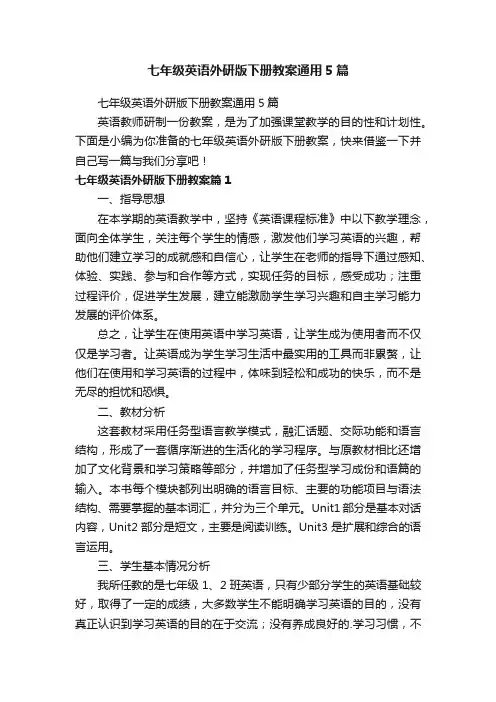
七年级英语外研版下册教案通用5篇七年级英语外研版下册教案通用5篇英语教师研制一份教案,是为了加强课堂教学的目的性和计划性。
下面是小编为你准备的七年级英语外研版下册教案,快来借鉴一下并自己写一篇与我们分享吧!七年级英语外研版下册教案篇1一、指导思想在本学期的英语教学中,坚持《英语课程标准》中以下教学理念,面向全体学生,关注每个学生的情感,激发他们学习英语的兴趣,帮助他们建立学习的成就感和自信心,让学生在老师的指导下通过感知、体验、实践、参与和合作等方式,实现任务的目标,感受成功;注重过程评价,促进学生发展,建立能激励学生学习兴趣和自主学习能力发展的评价体系。
总之,让学生在使用英语中学习英语,让学生成为使用者而不仅仅是学习者。
让英语成为学生学习生活中最实用的工具而非累赘,让他们在使用和学习英语的过程中,体味到轻松和成功的快乐,而不是无尽的担忧和恐惧。
二、教材分析这套教材采用任务型语言教学模式,融汇话题、交际功能和语言结构,形成了一套循序渐进的生活化的学习程序。
与原教材相比还增加了文化背景和学习策略等部分,并增加了任务型学习成份和语篇的输入。
本书每个模块都列出明确的语言目标、主要的功能项目与语法结构、需要掌握的基本词汇,并分为三个单元。
Unit1部分是基本对话内容,Unit2部分是短文,主要是阅读训练。
Unit3是扩展和综合的语言运用。
三、学生基本情况分析我所任教的是七年级1、2班英语,只有少部分学生的英语基础较好,取得了一定的成绩,大多数学生不能明确学习英语的目的,没有真正认识到学习英语的目的在于交流;没有养成良好的.学习习惯,不能做好课前预习课后复习,不善于发现和总结语言规律,不注意知识的巩固和积累。
四、具体措施1、每天背诵课文中的重点对话。
目的:要求学生背诵并默写英语句子,培养学生良好的英语语感。
2、每天听写本节课中需要用到的重点生词,常用句子或习语。
利用“互测及教师抽查”及时检查,保证效果并坚持下去。
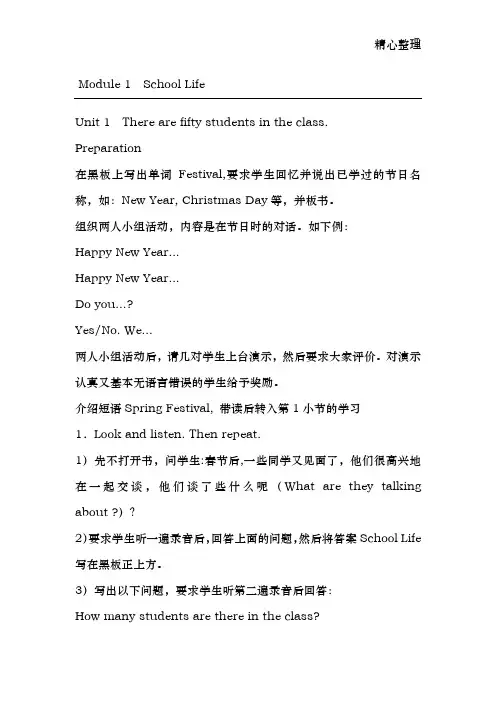
精心整理Module 1 School LifeUnit 1 There are fifty students in the class.Preparation在黑板上写出单词Festival,要求学生回忆并说出已学过的节日名2)要求学生听一遍录音后,回答上面的问题,然后将答案School Life 写在黑板正上方。
3)写出以下问题,要求学生听第二遍录音后回答:How many students are there in the class?How long are the lessons?How does Feifei go to school?How long does the bus take to get to school ?学生回答上述问题后翻开书,跟录音读一遍对话。
组织四人小组操练本段对话,然后要求他们演示和评价。
1.Look and listen. Then repeat.1)教师说:请同学们听第一段对话,然后回答:How many lessons does Gu Ming have each day?以下三段对话的教学方式与上相同,教学中使用的参考用题如下:What time is the recess?What’s Gu Ming’s favourite lesson?What does Ms Wang teach?2)学生答完问题后,要求他们跟读四段对话的录音。
3)学生跟读完对话后,教师组织两人小组操练这些对话,然后要求他们演示和评价。
教师说:有一位学生Susan 也对她的朋友谈了她的学校生活。
他们谈了些什么呢?1.Listen and say. Susan talks to her friend. Listen to what they say and repeat.1)教师说:请同学们听下面的对话,然后回答:Is Susan’s class big?How many students are there in her class?2)学生听一遍对话录音,然后回答上列问题。
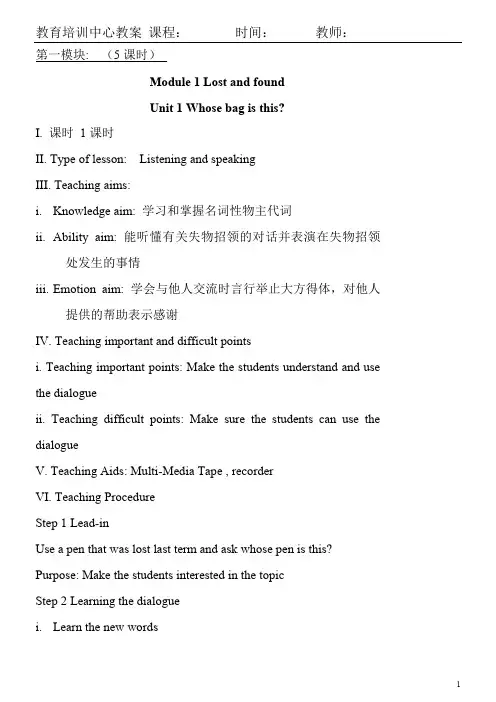
第一模块: (5课时)Module 1 Lost and foundUnit 1 Whose bag is this?I. 课时1课时II. Type of lesson: Listening and speakingIII. Teaching aims:i.Knowledge aim: 学习和掌握名词性物主代词ii.Ability aim: 能听懂有关失物招领的对话并表演在失物招领处发生的事情iii.Emotion aim: 学会与他人交流时言行举止大方得体,对他人提供的帮助表示感谢IV. Teaching important and difficult pointsi. Teaching important points: Make the students understand and use the dialogueii. Teaching difficult points: Make sure the students can use the dialogueV. Teaching Aids: Multi-Media Tape , recorderVI. Teaching ProcedureStep 1 Lead-inUse a pen that was lost last term and ask whose pen is this? Purpose: Make the students interested in the topicStep 2 Learning the dialoguei.Learn the new wordsActivity1 Match the words from the box with the pictures同步练习:Step 3 PronunciationStep 4 Sum up and exerciseStep 5: HomeworkVII. Blackboard writingVIII. 反思Unit 2 Are they yours?I. 课时2课时(课文讲解&练习)II. Type of lesson: Reading and writingIII. Teaching aims:iv.Knowledge aim: 学习和掌握新单词v.Ability aim: 能读懂有关失物招领的短文,能写出一则招领启事vi.Emotion aim: 学会与他人交流时言行举止大方得体,对他人提供的帮助表示感谢IV. Teaching important and difficult pointsi. Teaching important points: Make the students understand the passageii. Teaching difficult points: Make sure the students can find some useful information from the passage and write a lost and found note.V. Teaching Aids: Multi-Media Tape , recorderVI. Teaching ProcedureStep 1 Pre-readingLearn the new words and show the students a lost and found note, lead in the passage.Step 2 While-readingActivity 1: Listen and read the passage.Activity 2: Read the passage and answer the questions.Activity3: Translate and explain the language pointsActivity 4: Complete the passage with the correct form of the words and expressions from the box. (Activity3 on P5)Step 3 Post-readingWriting (Activity 4 on P5)Step 4 Sum up and exerciseStep 5: HomeworkVII. Blackboard writingVIII. 反思Unit 3 Language in useI. 课时2课时(课本练习&练习册)II. Type of lesson: GrammarIII. Teaching aims:vii.K nowledge aim: 名词性物主代词和形容词性物主代词的用法viii.Ability aim: 能利用名词性物主代词和形容词性物主代词解决一些问题ix.Emotion aim: 学会与他人交流时言行举止大方得体,对他人提供的帮助表示感谢IV. Teaching important and difficult pointsi. Teaching important points: Make the students solve some questionsii. Teaching difficult points: Make sure the students do the exercises V. Teaching Aids: Multi-Media Tape , recorderVI. Teaching ProcedureStep 1: Activity 1: Work in pairs. Ask and answer questions.The teacher prepare some school things, ask every pair to choose a school thing, show the students a model, like this:--Whose bag is this? Is it yours?--No, it’s not mine. It’s his.Give the students two minutes to make the dialogue, then present in the class.Activity 2: Complete the sentences with the correct form of the words from the box.Give the students three minutes to finish it themselves, then check the answers together.Step 3: Match the words from Box A with the words from Box B. This activity is very easy, so the students can do it together.Step 4: Around the world---The Internet lost and foundAsk the students read by themselves, then translate one by one, the teacher explain the language points.Step 5: Activity 4: Work in pairs.The teacher prepares some things such as camera, crayons, football, gloves, mobile phone, wallet, watch and so on.Student A: Think of three or four things he/she has lost or he/she can choose from the box. Describe them.Student B: Think of five or six things you have in your lost and found office or you can choose from the box. Describe them.Then ask and answer questions.Student A: Ask Student B if they’ve got the things you have lost. Answer questions about details.Student B: Answer questions about the things Student A has lost. Ask questions about details.Give the students five minutes to prepare, then act out in the class. Step 6: HomeworkVII. Blackboard writingUnit 3 Language in useVIII. 反思第二模块(5课时)Module 2 What can you do?Teaching aims:1. Knowledge aim: 学习和掌握情态动词“can”.2. Ability aim: 能正确使用情态动词“can”表示能力的肯定、否定与疑问形式。
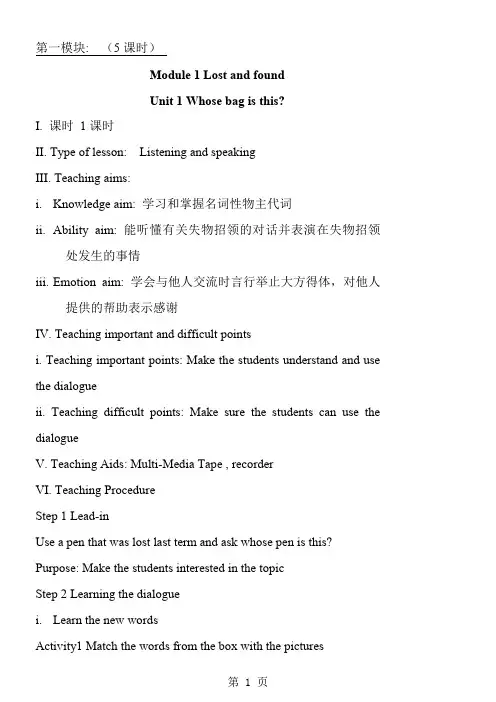
第一模块: (5课时)Module 1 Lost and foundUnit 1 Whose bag is this?I. 课时1课时II. Type of lesson: Listening and speakingIII. Teaching aims:i.Knowledge aim: 学习和掌握名词性物主代词ii.Ability aim: 能听懂有关失物招领的对话并表演在失物招领处发生的事情iii.Emotion aim: 学会与他人交流时言行举止大方得体,对他人提供的帮助表示感谢IV. Teaching important and difficult pointsi. Teaching important points: Make the students understand and use the dialogueii. Teaching difficult points: Make sure the students can use the dialogueV. Teaching Aids: Multi-Media Tape , recorderVI. Teaching ProcedureStep 1 Lead-inUse a pen that was lost last term and ask whose pen is this? Purpose: Make the students interested in the topicStep 2 Learning the dialoguei.Learn the new wordsActivity1 Match the words from the box with the pictures同步练习:Step 3 PronunciationStep 4 Sum up and exerciseStep 5: HomeworkVII. Blackboard writingVIII. 反思Unit 2 Are they yours?I. 课时2课时(课文讲解&练习)II. Type of lesson: Reading and writingIII. Teaching aims:iv.Knowledge aim: 学习和掌握新单词v.Ability aim: 能读懂有关失物招领的短文,能写出一则招领启事vi.Emotion aim: 学会与他人交流时言行举止大方得体,对他人提供的帮助表示感谢IV. Teaching important and difficult pointsi. Teaching important points: Make the students understand the passageii. Teaching difficult points: Make sure the students can find some useful information from the passage and write a lost and found note. V. Teaching Aids: Multi-Media Tape , recorderVI. Teaching ProcedureStep 1 Pre-readingLearn the new words and show the students a lost and found note,lead in the passage.Step 2 While-readingActivity 1: Listen and read the passage.Activity 2: Read the passage and answer the questions.Activity3: Translate and explain the language pointsActivity 4: Complete the passage with the correct form of the words and expressions from the box. (Activity3 on P5)Step 3 Post-readingWriting (Activity 4 on P5)Step 4 Sum up and exerciseStep 5: HomeworkVII. Blackboard writingVIII. 反思Unit 3 Language in useI. 课时2课时(课本练习&练习册)II. Type of lesson: GrammarIII. Teaching aims:vii.K nowledge aim: 名词性物主代词和形容词性物主代词的用法viii.Ability aim: 能利用名词性物主代词和形容词性物主代词解决一些问题ix.Emotion aim: 学会与他人交流时言行举止大方得体,对他人提供的帮助表示感谢IV. Teaching important and difficult pointsi. Teaching important points: Make the students solve somequestionsii. Teaching difficult points: Make sure the students do the exercises V. Teaching Aids: Multi-Media Tape , recorderVI. Teaching ProcedureStep 1: Activity 1: Work in pairs. Ask and answer questions.The teacher prepare some school things, ask every pair to choose a school thing, show the students a model, like this:--Whose bag is this? Is it yours?--No, it’s not mine. It’s his.Give the students two minutes to make the dialogue, then present in the class.Activity 2: Complete the sentences with the correct form of the words from the box.Give the students three minutes to finish it themselves, then check the answers together.Step 3: Match the words from Box A with the words from Box B. This activity is very easy, so the students can do it together.Step 4: Around the world---The Internet lost and foundAsk the students read by themselves, then translate one by one, the teacher explain the language points.Step 5: Activity 4: Work in pairs.The teacher prepares some things such as camera, crayons, football, gloves, mobile phone, wallet, watch and so on.Student A: Think of three or four things he/she has lost or he/she canchoose from the box. Describe them.Student B: Think of five or six things you have in your lost and found office or you can choose from the box. Describe them.Then ask and answer questions.Student A: Ask Student B if they’ve got the things you have lost. Answer questions about details.Student B: Answer questions about the things Student A has lost. Ask questions about details.Give the students five minutes to prepare, then act out in the class. Step 6: HomeworkVII. Blackboard writingUnit 3 Language in useVIII. 反思第二模块(5课时)Module 2 What can you do?Teaching aims:1. Knowledge aim: 学习和掌握情态动词“can”.2. Ability aim: 能正确使用情态动词“can”表示能力的肯定、否定与疑问形式。
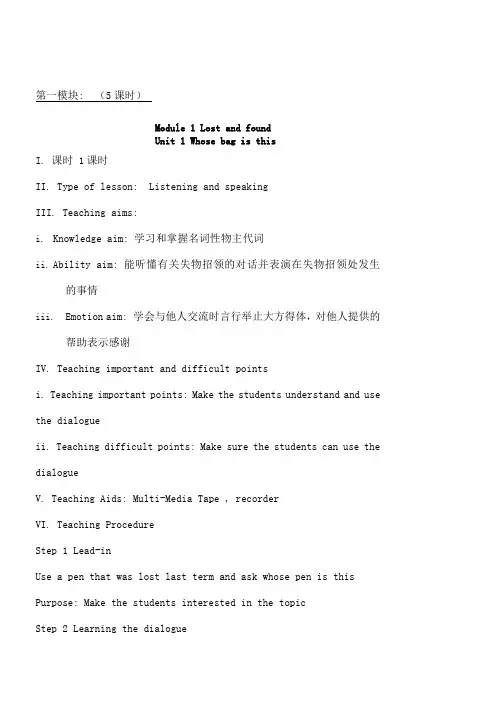
第一模块: (5课时)Module 1 Lost and foundUnit 1 Whose bag is thisI. 课时 1课时II. Type of lesson: Listening and speakingIII. Teaching aims:i.Knowledge aim: 学习和掌握名词性物主代词ii.Ability aim: 能听懂有关失物招领的对话并表演在失物招领处发生的事情iii.Emotion aim: 学会与他人交流时言行举止大方得体,对他人提供的帮助表示感谢IV. Teaching important and difficult pointsi. Teaching important points: Make the students understand and use the dialogueii. Teaching difficult points: Make sure the students can use the dialogueV. Teaching Aids: Multi-Media Tape , recorderVI. Teaching ProcedureStep 1 Lead-inUse a pen that was lost last term and ask whose pen is this Purpose: Make the students interested in the topicStep 2 Learning the dialoguei.Learn the new wordsActivity1 Match the words from the box with the pictures同步练习:Step 3 PronunciationStep 4 Sum up and exerciseStep 5: HomeworkVII. Blackboard writingVIII. 反思Unit 2 Are they yoursI. 课时 2课时(课文讲解&练习)II. Type of lesson: Reading and writingIII. Teaching aims:iv.Knowledge aim: 学习和掌握新单词v.Ability aim: 能读懂有关失物招领的短文,能写出一则招领启事vi.Emotion aim: 学会与他人交流时言行举止大方得体,对他人提供的帮助表示感谢IV. Teaching important and difficult pointsi. Teaching important points: Make the students understand the passageii. Teaching difficult points: Make sure the students can find some useful information from the passage and write a lost and found note. V. Teaching Aids: Multi-Media Tape , recorderVI. Teaching ProcedureStep 1 Pre-readingLearn the new words and show the students a lost and found note, lead in the passage.Step 2 While-readingActivity 1: Listen and read the passage.Activity 2: Read the passage and answer the questions.Activity3: Translate and explain the language pointsActivity 4: Complete the passage with the correct form of the words and expressions from the box. (Activity3 on P5)Step 3 Post-readingWriting (Activity 4 on P5)Step 4 Sum up and exerciseStep 5: HomeworkVII. Blackboard writingVIII. 反思Unit 3 Language in useI. 课时 2课时(课本练习&练习册)II. Type of lesson: GrammarIII. Teaching aims:vii.Knowledge aim: 名词性物主代词和形容词性物主代词的用法viii.Ability aim: 能利用名词性物主代词和形容词性物主代词解决一些问题ix.Emotion aim: 学会与他人交流时言行举止大方得体,对他人提供的帮助表示感谢IV. Teaching important and difficult pointsi. Teaching important points: Make the students solve some questions ii. Teaching difficult points: Make sure the students do the exercisesV. Teaching Aids: Multi-Media Tape , recorderVI. Teaching ProcedureStep 1: Activity 1: Work in pairs. Ask and answer questions.The teacher prepare some school things, ask every pair to choose a school thing, show the students a model, like this:--Whose bag is this Is it yours--No, it’s not mine. It’s his.Give the students two minutes to make the dialogue, then present in the class.Activity 2: Complete the sentences with the correct form of the words from the box.Give the students three minutes to finish it themselves, then check the answers together.Step 3: Match the words from Box A with the words from Box B. This activity is very easy, so the students can do it together. Step 4: Around the world---The Internet lost and foundAsk the students read by themselves, then translate one by one, the teacher explain the language points.Step 5: Activity 4: Work in pairs.The teacher prepares some things such as camera, crayons, football,gloves, mobile phone, wallet, watch and so on.Student A: Think of three or four things he/she has lost or he/she can choose from the box. Describe them.Student B: Think of five or six things you have in your lost and found office or you can choose from the box. Describe them.Then ask and answer questions.Student A: Ask Student B if they’ve got the things you have lost. Answer questions about details.Student B: Answer questions about the things Student A has lost. Ask questions about details.Give the students five minutes to prepare, then act out in the class. Step 6: HomeworkVII. Blackboard writingUnit 3 Language in useVIII. 反思第二模块(5课时)Module 2 What can you doTeaching aims:1. Knowledge aim: 学习和掌握情态动词“can”.2. Ability aim: 能正确使用情态动词“can”表示能力的肯定、否定与疑问形式。
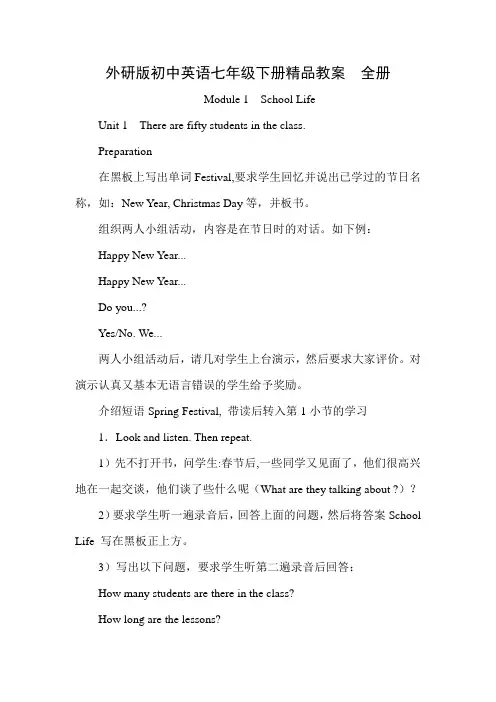
外研版初中英语七年级下册精品教案全册Module 1 School LifeUnit 1 There are fifty students in the class.Preparation在黑板上写出单词Festival,要求学生回忆并说出已学过的节日名称,如:New Year, Christmas Day等,并板书。
组织两人小组活动,内容是在节日时的对话。
如下例:Happy New Year...Happy New Year...Do you...?Yes/No. We...两人小组活动后,请几对学生上台演示,然后要求大家评价。
对演示认真又基本无语言错误的学生给予奖励。
介绍短语Spring Festival, 带读后转入第1小节的学习1.Look and listen. Then repeat.1)先不打开书,问学生:春节后,一些同学又见面了,他们很高兴地在一起交谈,他们谈了些什么呢(What are they talking about ?)?2)要求学生听一遍录音后,回答上面的问题,然后将答案School Life 写在黑板正上方。
3)写出以下问题,要求学生听第二遍录音后回答:How many students are there in the class?How long are the lessons?How does Feifei go to school?How long does the bus take to get to school ?学生回答上述问题后翻开书,跟录音读一遍对话。
组织四人小组操练本段对话,然后要求他们演示和评价。
第2、3、4小节的教学可参考“教师用书”的建议进行。
Unit 2 What’s your favourite lesson?Preparation1)教师先简单用英语介绍本班的一些情况,然后要求学生分两人小组就School life话题进行对话,也可以给出以下问题要求学生对话:Do you like your school?How many lessons do you have each day?How do you get to school?两人小组活动后,叫几对学生上台演示,然后要求大家评价。
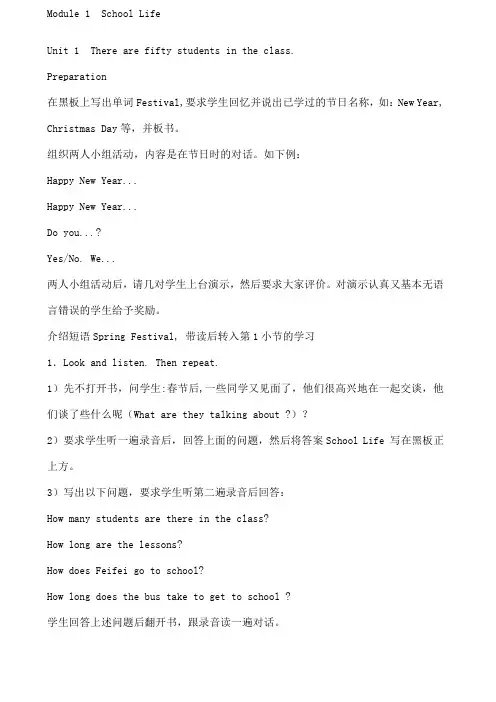
Module 1 School LifeUnit 1 There are fifty students in the class.Preparation在黑板上写出单词Festival,要求学生回忆并说出已学过的节日名称,如:New Year, Christmas Day等,并板书。
组织两人小组活动,内容是在节日时的对话。
如下例:Happy New Year...Happy New Year...Do you...?Yes/No. We...两人小组活动后,请几对学生上台演示,然后要求大家评价。
对演示认真又基本无语言错误的学生给予奖励。
介绍短语Spring Festival, 带读后转入第1小节的学习1.Look and listen. Then repeat.1)先不打开书,问学生:春节后,一些同学又见面了,他们很高兴地在一起交谈,他们谈了些什么呢(What are they talking about ?)?2)要求学生听一遍录音后,回答上面的问题,然后将答案School Life 写在黑板正上方。
3)写出以下问题,要求学生听第二遍录音后回答:How many students are there in the class?How long are the lessons?How does Feifei go to school?How long does the bus take to get to school ?学生回答上述问题后翻开书,跟录音读一遍对话。
组织四人小组操练本段对话,然后要求他们演示和评价。
第2、3、4小节的教学可参考“教师用书”的建议进行。
Unit 2 What’s your favourite lesson?Preparation1)教师先简单用英语介绍本班的一些情况,然后要求学生分两人小组就School life 话题进行对话,也可以给出以下问题要求学生对话:Do you like your school?How many lessons do you have each day?How do you get to school?两人小组活动后,叫几对学生上台演示,然后要求大家评价。

外研版初一英语下全册教案文档编制序号:[KK8UY-LL9IO69-TTO6M3-MTOL89-FTT688]第一模块: (5课时)Module 1 Lost and foundUnit 1 Whose bag is thisI. 课时 1课时II. Type of lesson: Listening and speakingIII. Teaching aims:i.Knowledge aim: 学习和掌握名词性物主代词ii.Ability aim: 能听懂有关失物招领的对话并表演在失物招领处发生的事情iii.Emotion aim: 学会与他人交流时言行举止大方得体,对他人提供的帮助表示感谢IV. Teaching important and difficult pointsi. Teaching important points: Make the students understand and use the dialogueii. Teaching difficult points: Make sure the students can use the dialogueV. Teaching Aids: Multi-Media Tape , recorderVI. Teaching ProcedureStep 1 Lead-inUse a pen that was lost last term and ask whose pen is this Purpose: Make the students interested in the topicStep 2 Learning the dialoguei.Learn the new wordsActivity1 Match the words from the box with the pictures同步练习:Step 3 PronunciationStep 4 Sum up and exerciseStep 5: HomeworkVII. Blackboard writingVIII. 反思Unit 2 Are they yoursI. 课时 2课时(课文讲解&练习)II. Type of lesson: Reading and writingIII. Teaching aims:iv.Knowledge aim: 学习和掌握新单词v.Ability aim: 能读懂有关失物招领的短文,能写出一则招领启事vi.Emotion aim: 学会与他人交流时言行举止大方得体,对他人提供的帮助表示感谢IV. Teaching important and difficult pointsi. Teaching important points: Make the students understand the passageii. Teaching difficult points: Make sure the students can find some useful information from the passage and write a lost and found note.V. Teaching Aids: Multi-Media Tape , recorderVI. Teaching ProcedureStep 1 Pre-readingLearn the new words and show the students a lost and found note, lead in the passage.Step 2 While-readingActivity 1: Listen and read the passage.Activity 2: Read the passage and answer the questions.Activity3: Translate and explain the language pointsActivity 4: Complete the passage with the correct form of the words and expressions from the box. (Activity3 on P5)Step 3 Post-readingWriting (Activity 4 on P5)Step 4 Sum up and exerciseStep 5: HomeworkVII. Blackboard writingVIII. 反思Unit 3 Language in useI. 课时 2课时(课本练习&练习册)II. Type of lesson: GrammarIII. Teaching aims:vii.Knowledge aim: 名词性物主代词和形容词性物主代词的用法viii.Ability aim: 能利用名词性物主代词和形容词性物主代词解决一些问题ix.Emotion aim: 学会与他人交流时言行举止大方得体,对他人提供的帮助表示感谢IV. Teaching important and difficult pointsi. Teaching important points: Make the students solve some questionsii. Teaching difficult points: Make sure the students do the exercisesV. Teaching Aids: Multi-Media Tape , recorderVI. Teaching ProcedureStep 1: Activity 1: Work in pairs. Ask and answer questions. The teacher prepare some school things, ask every pair to choose a school thing, show the students a model, like this: --Whose bag is this Is it yours--No, it’s not mine. It’s his.Give the students two minutes to make the dialogue, then present in the class.Activity 2: Complete the sentences with the correct form of the words from the box.Give the students three minutes to finish it themselves, then check the answers together.Step 3: Match the words from Box A with the words from Box B. This activity is very easy, so the students can do it together.Step 4: Around the world---The Internet lost and foundAsk the students read by themselves, then translate one by one, the teacher explain the language points.Step 5: Activity 4: Work in pairs.The teacher prepares some things such as camera, crayons, football, gloves, mobile phone, wallet, watch and so on. Student A: Think of three or four things he/she has lost or he/she can choose from the box. Describe them.Student B: Think of five or six things you have in your lost and found office or you can choose from the box. Describe them.Then ask and answer questions.Student A: Ask Student B if they’ve got the things you have lost. Answer questions about details.Student B: Answer questions about the things Student A has lost. Ask questions about details.Give the students five minutes to prepare, then act out in the class.Step 6: HomeworkVII. Blackboard writingUnit 3 Language in useVIII. 反思第二模块(5课时)Module 2 What can you doTeaching aims:1. Knowledge aim: 学习和掌握情态动词“can”.2. Ability aim: 能正确使用情态动词“can”表示能力的肯定、否定与疑问形式。
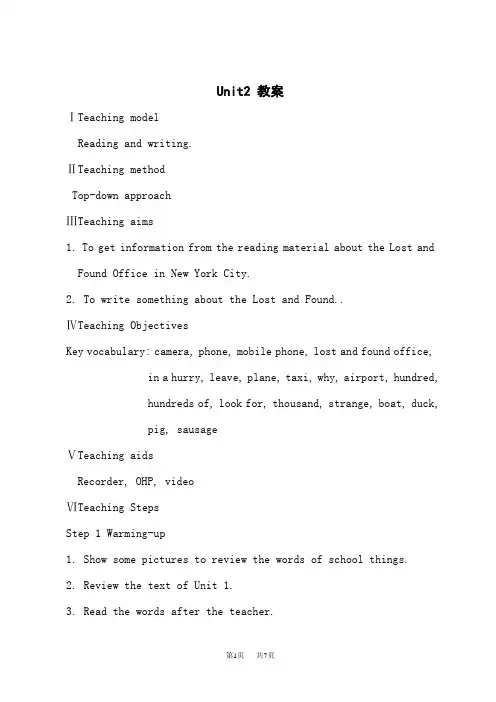
Unit2 教案ⅠTeaching modelReading and writing.ⅡTeaching methodTop-down approachⅢTeaching aims1. To get information from the reading material about the Lost and Found Office in New York City.2. To write something about the Lost and Found..ⅣTeaching ObjectivesKey vocabulary: camera, phone, mobile phone, lost and found office, in a hurry, leave, plane, taxi, why, airport, hundred,hundreds of, look for, thousand, strange, boat, duck,pig, sausageⅤTeaching aidsRecorder, OHP, videoⅥTeaching StepsStep 1 Warming-up1. Show some pictures to review the words of school things.2. Review the text of Unit 1.3. Read the words after the teacher.4. Introduce the new words.Step 2 Complete the sentences.1. Ask the students to read the words in the box in Activity 1.2. Look at pictures in Activity 1 carefully.3. Read through the sentences.A man is talking to a woman at the lost and found office. He’s looking for his ______.A man is getting on the bus. His ________ is lost.4. Complete the sentences with the correct words and e the box5. Ask the students to check with a partner.6. Check the answers:Keys: 1. camera 2. mobile phoneStep 3 Reading.1. Play the recording.2. Ask the students to read through the passage.3. Read the passage and answer the questions.1) When do people often lose things?2) Why are there lost and found offices at airports and stations?3) What do people do at the lost and found office?4) What strange things are there at the New York City Lost and FoundOffice?4. Check with a partner.5. Call back the answers from the whole class.Keys:1. People often lose things when they’re travelling or when they’re in a hurry.2. Because people leave things on planes, on trains, on buses and in taxis.3. They look for things they have lost.4. There are about a hundred bikes, a large boat, a lot of animals and some sausages.6. Read the text together.7. Learning to learn.Reading passages with interesting facts can help you understand and remember English. Try to find passages with facts to read. Step 4 Do exercises.1. Ask the students to the words in the box in Activity 3.2. Ask the students to read through the passage in Activity3.People in a hurry often (1)_______ things, and there are(2)______ things at lost and found offices at (3)______ and (4)______. At the New York City Lost and Found Office, there are also some very (5)______ things. There are fifteen kilos of (6)______ — are they yours? And how do you lose a (7)_______ boat on a train?3. Complete the passage with the correct from of the words and e the box..4. Check with a partner.5. Call back the answers from the whole class.6. Read the passage together.Keys: 1. lose 2. hundreds of 3. airports 4. stations 5. strange 6. sausages 7. largeStep 5 Guessing game.1. Show some pictures.2. According to the information given and ask the students to guess what it is.3. Show the pictures to check the answers.Step 6 Writing.4. Read the lost and found notes. Write notes for two more things.2. Check with a partner.3. Call back the answers from the whole class.Step 7 Do exercises:Ⅰ.根据句意及汉语提示写出句中所缺单词。
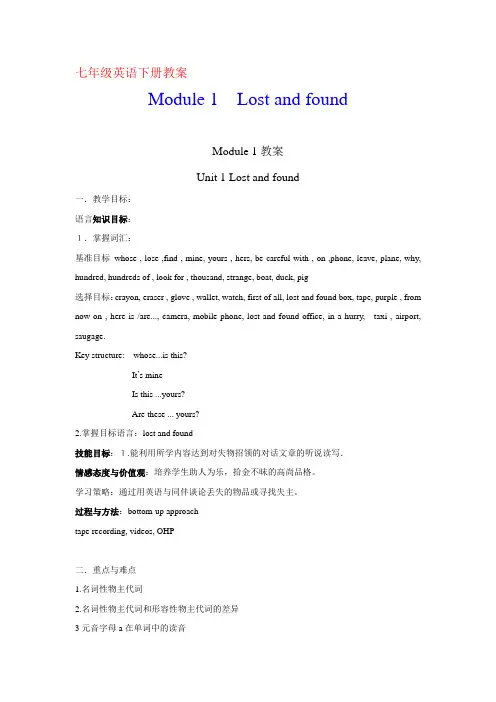
七年级英语下册教案Module 1 Lost and foundModule 1教案Unit 1 Lost and found一.教学目标:语言知识目标:1.掌握词汇:基准目标whose , lose ,find , mine, yours , hers, be careful with , on ,phone, leave, plane, why, hundred, hundreds of , look for , thousand, strange, boat, duck, pig选择目标:crayon, eraser , glove , wallet, watch, first of all, lost and found box, tape, purple , from now on , here is /are..., camera, mobile phone, lost and found office, in a hurry, taxi , airport, saugage.Key structure: whose...is this?It’s mineIs this ...yours?Are these ... yours?2.掌握目标语言:lost and found技能目标:1.能利用所学内容达到对失物招领的对话文章的听说读写.情感态度与价值观:培养学生助人为乐,拾金不昧的高尚品格。
学习策略:通过用英语与同伴谈论丢失的物品或寻找失主。
过程与方法:bottom-up approachtape recording, videos, OHP二.重点与难点1.名词性物主代词2.名词性物主代词和形容性物主代词的差异3元音字母a在单词中的读音三.教材与学情分析四.教学过程教学反思:本课活动的设计层级性强,能依照语言的学习规律,帮助学生系统的进行知识的构建,对技能的训练也是由简到繁,先输入后产出。
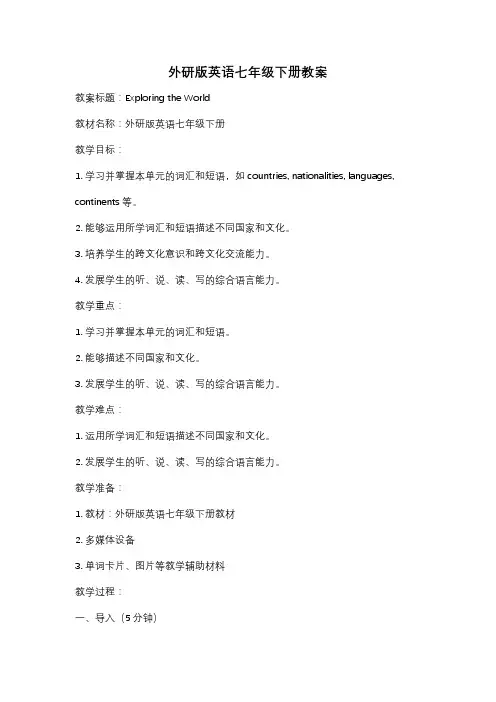
外研版英语七年级下册教案教案标题:Exploring the World教材名称:外研版英语七年级下册教学目标:1. 学习并掌握本单元的词汇和短语,如countries, nationalities, languages, continents等。
2. 能够运用所学词汇和短语描述不同国家和文化。
3. 培养学生的跨文化意识和跨文化交流能力。
4. 发展学生的听、说、读、写的综合语言能力。
教学重点:1. 学习并掌握本单元的词汇和短语。
2. 能够描述不同国家和文化。
3. 发展学生的听、说、读、写的综合语言能力。
教学难点:1. 运用所学词汇和短语描述不同国家和文化。
2. 发展学生的听、说、读、写的综合语言能力。
教学准备:1. 教材:外研版英语七年级下册教材2. 多媒体设备3. 单词卡片、图片等教学辅助材料教学过程:一、导入(5分钟)1. 利用多媒体设备展示一些国家的图片,引发学生对不同国家和文化的兴趣。
2. 引导学生回忆上一单元所学的内容,复习有关国家和文化的词汇。
二、新课呈现(15分钟)1. 利用多媒体设备展示本单元的新词汇和短语,如countries, nationalities, languages, continents等。
2. 通过图片和实物等教学辅助材料,让学生理解和记忆新词汇和短语的意义和用法。
三、合作探究(20分钟)1. 学生分组,每组选择一个国家进行研究。
他们需要了解该国的地理位置、语言、风俗习惯等。
2. 学生利用图书馆、互联网等资源进行调查和收集相关信息。
3. 学生用所学的词汇和短语描述他们选择的国家,并向全班展示他们的研究成果。
四、巩固练习(15分钟)1. 学生完成课本上的练习题,以巩固所学内容。
2. 教师进行检查和评价,给予学生及时的反馈。
五、拓展延伸(10分钟)1. 学生分组进行角色扮演,模拟跨文化交流的情境。
2. 学生可以运用所学的词汇和短语,以及自己的想象力,进行对话和交流。
第一模块: (5课时)Module 1 Lost and foundUnit 1 Whose bag is this?I. 课时1课时II. Type of lesson: Listening and speakingIII. Teaching aims:i.Knowledge aim: 学习和掌握名词性物主代词ii.Ability aim: 能听懂有关失物招领的对话并表演在失物招领处发生的事情iii.Emotion aim: 学会与他人交流时言行举止大方得体,对他人提供的帮助表示感谢IV. Teaching important and difficult pointsi. Teaching important points: Make the students understand and use the dialogueii. Teaching difficult points: Make sure the students can use the dialogueV. Teaching Aids: Multi-Media Tape , recorderVI. Teaching ProcedureStep 1 Lead-inUse a pen that was lost last term and ask whose pen is this? Purpose: Make the students interested in the topicStep 2 Learning the dialoguei.Learn the new wordsActivity1 Match the words from the box with the pictures同步练习:Step 3 PronunciationStep 4 Sum up and exerciseStep 5: HomeworkVII. Blackboard writingVIII. 反思Unit 2 Are they yours?I. 课时2课时(课文讲解&练习)II. Type of lesson: Reading and writingIII. Teaching aims:iv.Knowledge aim: 学习和掌握新单词v.Ability aim: 能读懂有关失物招领的短文,能写出一则招领启事vi.Emotion aim: 学会与他人交流时言行举止大方得体,对他人提供的帮助表示感谢IV. Teaching important and difficult pointsi. Teaching important points: Make the students understand the passageii. Teaching difficult points: Make sure the students can find some useful information from the passage and write a lost and found note.V. Teaching Aids: Multi-Media Tape , recorderVI. Teaching ProcedureStep 1 Pre-readingLearn the new words and show the students a lost and found note, lead in the passage.Step 2 While-readingActivity 1: Listen and read the passage.Activity 2: Read the passage and answer the questions.Activity3: Translate and explain the language pointsActivity 4: Complete the passage with the correct form of the words and expressions from the box. (Activity3 on P5)Step 3 Post-readingWriting (Activity 4 on P5)Step 4 Sum up and exerciseStep 5: HomeworkVII. Blackboard writingVIII. 反思Unit 3 Language in useI. 课时2课时(课本练习&练习册)II. Type of lesson: GrammarIII. Teaching aims:vii.K nowledge aim: 名词性物主代词和形容词性物主代词的用法viii.Ability aim: 能利用名词性物主代词和形容词性物主代词解决一些问题ix.Emotion aim: 学会与他人交流时言行举止大方得体,对他人提供的帮助表示感谢IV. Teaching important and difficult pointsi. Teaching important points: Make the students solve some questionsii. Teaching difficult points: Make sure the students do the exercises V. Teaching Aids: Multi-Media Tape , recorderVI. Teaching ProcedureStep 1: Activity 1: Work in pairs. Ask and answer questions.The teacher prepare some school things, ask every pair to choose a school thing, show the students a model, like this:--Whose bag is this? Is it yours?--No, it’s not mine. It’s his.Give the students two minutes to make the dialogue, then present in the class.Activity 2: Complete the sentences with the correct form of the words from the box.Give the students three minutes to finish it themselves, then check the answers together.Step 3: Match the words from Box A with the words from Box B. This activity is very easy, so the students can do it together.Step 4: Around the world---The Internet lost and foundAsk the students read by themselves, then translate one by one, the teacher explain the language points.Step 5: Activity 4: Work in pairs.The teacher prepares some things such as camera, crayons, football, gloves, mobile phone, wallet, watch and so on.Student A: Think of three or four things he/she has lost or he/she can choose from the box. Describe them.Student B: Think of five or six things you have in your lost and found office or you can choose from the box. Describe them.Then ask and answer questions.Student A: Ask Student B if they’ve got the things you have lost. Answer questions about details.Student B: Answer questions about the things Student A has lost. Ask questions about details.Give the students five minutes to prepare, then act out in the class. Step 6: HomeworkVII. Blackboard writingUnit 3 Language in useVIII. 反思第二模块(5课时)Module 2 What can you do?Teaching aims:1. Knowledge aim: 学习和掌握情态动词“can”.2. Ability aim: 能正确使用情态动词“can”表示能力的肯定、否定与疑问形式。
Module 1 School LifeUnit 1 There are fifty students in the class.Preparation在黑板上写出单词Festival,要求学生回忆并说出已学过的节日名称,如:New Year, Christmas Day等,并板书。
组织两人小组活动,内容是在节日时的对话。
如下例:Happy New Year...Happy New Year...Do you...?Yes/No. We...两人小组活动后,请几对学生上台演示,然后要求大家评价。
对演示认真又基本无语言错误的学生给予奖励。
介绍短语Spring Festival, 带读后转入第1小节的学习1.Look and listen. Then repeat.1)先不打开书,问学生:春节后,一些同学又见面了,他们很高兴地在一起交谈,他们谈了些什么呢(What are they talking about ?)?2)要求学生听一遍录音后,回答上面的问题,然后将答案School Life 写在黑板正上方。
3)写出以下问题,要求学生听第二遍录音后回答:How many students are there in the class?How long are the lessons?How does Feifei go to school?How long does the bus take to get to school ?学生回答上述问题后翻开书,跟录音读一遍对话。
组织四人小组操练本段对话,然后要求他们演示和评价。
第2、3、4小节的教学可参考“教师用书”的建议进行。
Unit 2 What’s your favourite lesson?Preparation1)教师先简单用英语介绍本班的一些情况,然后要求学生分两人小组就School life话题进行对话,也可以给出以下问题要求学生对话:Do you like your school?How many lessons do you have each day?How do you get to school?两人小组活动后,叫几对学生上台演示,然后要求大家评价。